人教版八年级下册unit6.教案
- 格式:doc
- 大小:30.50 KB
- 文档页数:4
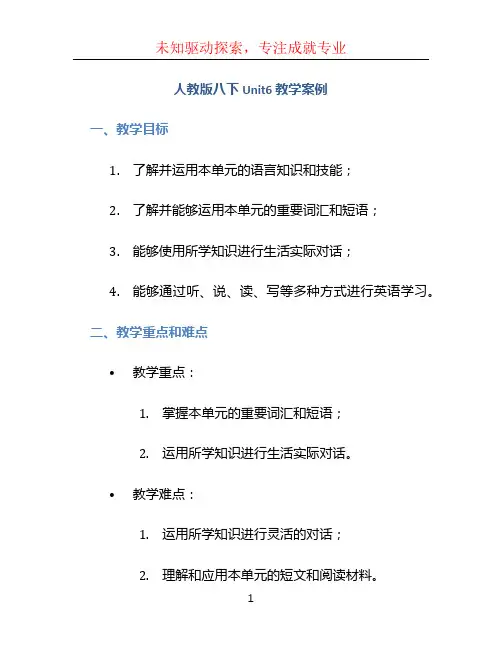
人教版八下Unit6 教学案例一、教学目标1.了解并运用本单元的语言知识和技能;2.了解并能够运用本单元的重要词汇和短语;3.能够使用所学知识进行生活实际对话;4.能够通过听、说、读、写等多种方式进行英语学习。
二、教学重点和难点•教学重点:1.掌握本单元的重要词汇和短语;2.运用所学知识进行生活实际对话。
•教学难点:1.运用所学知识进行灵活的对话;2.理解和应用本单元的短文和阅读材料。
三、教学过程1. 导入新课•准备一副图片展示农村和城市的风景,引发学生对于农村和城市的讨论。
•利用图片引导学生运用所学词汇描述农村和城市的不同之处。
2. 情景对话•学生分为小组进行角色扮演对话,假设他们是农村的孩子和城市的孩子,互相交换生活经历。
•引导学生使用本单元的目标句型表达自己的观点和感受。
3. 听力训练•播放录音,让学生跟读对话,强化语音和语调。
•再次播放录音,让学生回答与对话相关的问题,培养他们的听力能力。
4. 阅读练习•学生阅读课本中的短文,理解其中的重点信息和关键词。
•学生回答与短文相关的问题,检验他们对于短文内容的理解程度。
5. 语法重点•教师通过解释和例句的方式,让学生理解并掌握本单元的语法要点。
•学生进行语法练习,巩固所学知识。
6. 写作练习•引导学生运用所学知识,写一篇关于农村和城市的对比文章。
•帮助学生修改和提升写作水平,提供反馈和建议。
四、教学评价•通过教学过程中的角色扮演、听力训练、阅读练习和写作练习等形式,评估学生的语言运用能力和理解能力。
•对学生的发音、流利度、词汇运用、语法和写作进行评分,帮助他们发现自己的问题并加以改进。
五、教学延伸•建议学生自主学习,利用互联网资源和其他课外教材进一步扩展对农村和城市的了解,搜集更多的相关信息。
•鼓励学生进行小组讨论,分享和交流自己对于农村和城市的看法,提升口语表达能力。
六、教学总结本堂课主要围绕农村和城市的对比展开,通过角色扮演、听力训练、阅读练习和写作练习等多种方式,旨在提高学生的英语综合能力。
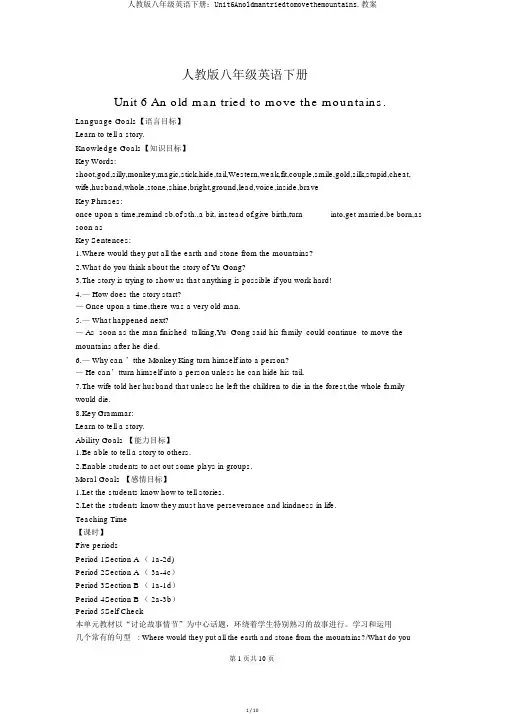
人教版八年级英语下册Unit 6 An old man tried to move the mountains.Language Goals【语言目标】Learn to tell a story.Knowledge Goals【知识目标】Key Words:shoot,god,silly,monkey,magic,stick,hide,tail,Western,weak,fit,couple,smile,gold,silk,stupid,cheat, wife,husband,whole,stone,shine,bright,ground,lead,voice,inside,braveKey Phrases:once upon a time,remind sb.of sth.,a bit, instead of,give birth,turn into,get married,be born,as soon asKey Sentences:1.Where would they put all the earth and stone from the mountains?2.What do you think about the story of Yu Gong?3.The story is trying to show us that anything is possible if you work hard!4.— How does the story start?— Once upon a time,there was a very old man.5.— What happened next?— As soon as the man finished talking,Yu Gong said his family could continue to move themountains after he died.6.— Why can ’tthe Monkey King turn himself into a person?— He can’tturn himself into a person unless he can hide his tail.7.The wife told her husband that unless he left the children to die in the forest,the whole family would die.8.Key Grammar:Learn to tell a story.Ability Goals 【能力目标】1.Be able to tell a story to others.2.Enable students to act out some plays in groups.Moral Goals 【感情目标】1.Let the students know how to tell stories.2.Let the students know they must have perseverance and kindness in life.Teaching Time【课时】Five periodsPeriod 1Section A ( 1a-2d)Period 2Section A ( 3a-4c)Period 3Section B ( 1a-1d)Period 4Section B ( 2a-3b)Period 5Self Check本单元教材以“讨论故事情节”为中心话题,环绕着学生特别熟习的故事进行。
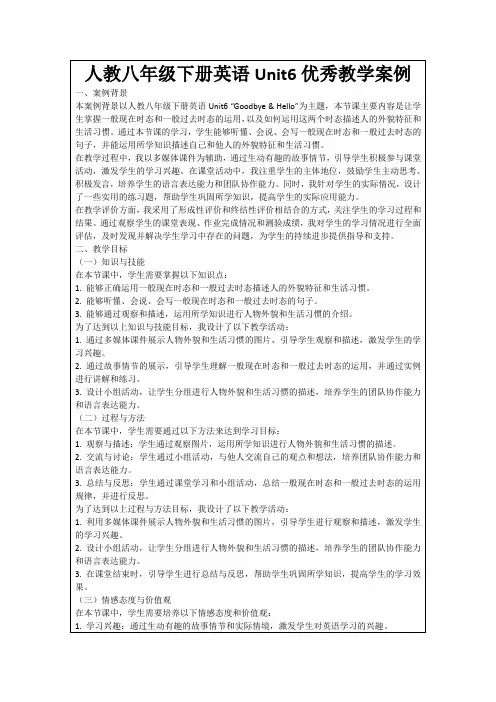
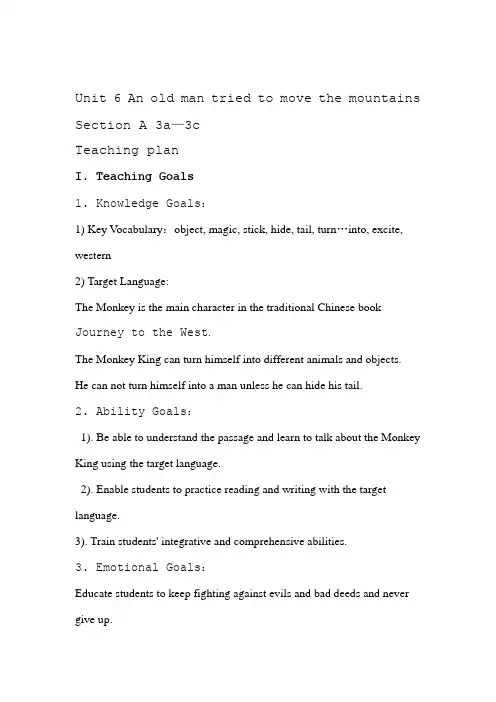
Unit 6 An old man tried to move the mountains Section A 3a—3cTeaching planI. Teaching Goals1. Knowledge Goals:1) Key V ocabulary:object, magic, stick, hide, tail, turn…into, excite, western2) Target Language:The Monkey is the main character in the traditional Chinese bookJourney to the West.The Monkey King can turn himself into different animals and objects.He can not turn himself into a man unless he can hide his tail.2. Ability Goals:1). Be able to understand the passage and learn to talk about the Monkey King using the target language.2). Enable students to practice reading and writing with the target language.3). Train students' integrative and comprehensive abilities.3. Emotional Goals:Educate students to keep fighting against evils and bad deeds and never give up.II. Key points and difficult points1. Key Vocabulary:object, magic, stick, hide, tail, turn…into, excite, western2. Key Expressions:The Monkey is the main character in the traditional Chinese book Journey to the West.The Monkey King can turn himself into different animals and objects.He can not turn himself into a man unless he can hide his tail.3. Difficult Points:Be able to understand the fairy story and tell their favorite story with target language.III. Teaching steps.1. Greetings2. Review: Do you know these traditional stories of China?3. Watch a video4. Talk about the four main characters especially the Monkey King.5. How much do you know about the Monkey King?6. Teach the new words by showing some pictures.New words: hide—hid, turn…into, object, magic stick, tail, excite, western.7. While reading: Task 1: SkimmingRead the passage quickly and finish answering the question and matchthe main idea with each paragraph. They have two minutes. Question: Which book is talked about?Match the main idea.Paragraph 1 Western children are also becoming interested in thestories of the Monkey King.Paragraph 2 The Monkey King is new to pupils in England but notto Chinese children.Paragraph 3 The Monkey King is not just normal monkey. He can do magical things.8. Check the answer.9. While reading: Task 2: Careful reading.Read paragraph 1 and tell T or F in two minutes.1). In November 1978, pupils in England were able to watch a new TV program called Monkey. ()2). Most of them were hearing this story for the second time. ()3). The Monkey King is the main character in the traditional Chinese book Journey to the west. ()Ask three students to tell their answers. If it is true, move to the next one, if it is false, ask the students to tell the correct answer. Then read the three sentences together.10. Careful reading: Read paragraph 2 and finish the mind map. Time limit: 2 minutes.11. Check the answer.12. Read paragraph 3 and finish another mind map. Then check the answer.13. Finish 3c. Check the answer after they finish it. Read these sentences together.14. Game: House of card. (Optional)1). Tell the rules of the game: Choose a card. If you are lucky enough you can get into the house directly and get some points. If you choose a number and you are asked to answer a question, then you have to answer it correctly to get some points. If you don't give the right answer, there will be no points for you. And if you give up, no points either.2). Play the game.15. Read the passage while listening. Pay attention to the pronunciation.16. Discussion: What do you think of the Monkey King? What is he like? Ask Ss to talk about their own opinion freely.17. Summary: We talk about the main character the Monkey King from Journey to the West. He can do many things, but he cannot turn himself into a man unless he can hide his tail. His spirit should be learned by children both from China and Western countries.18. Homework: 1). Tell your family or classmates about the Monkey King in English. 2). Try to recite the passage.Remember: Never give up and be helpful. Where there is a will, there is away.19. Blackboard design.Unit 6 An old man tried to move the mountains. Section A 33cWords or expressions(Optional)Evaluation System。
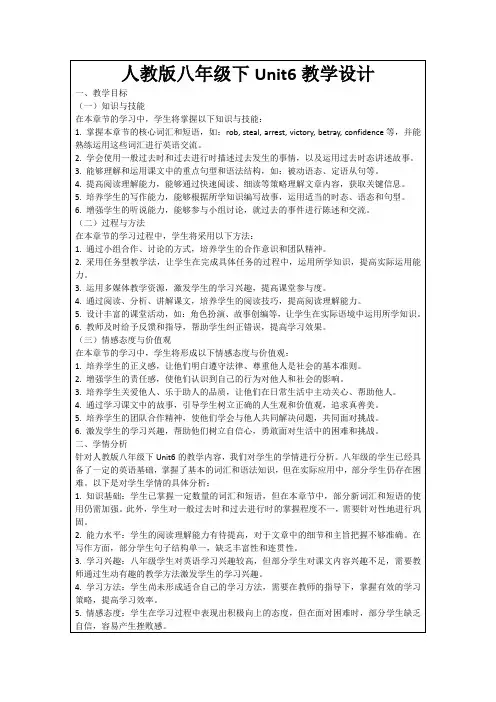
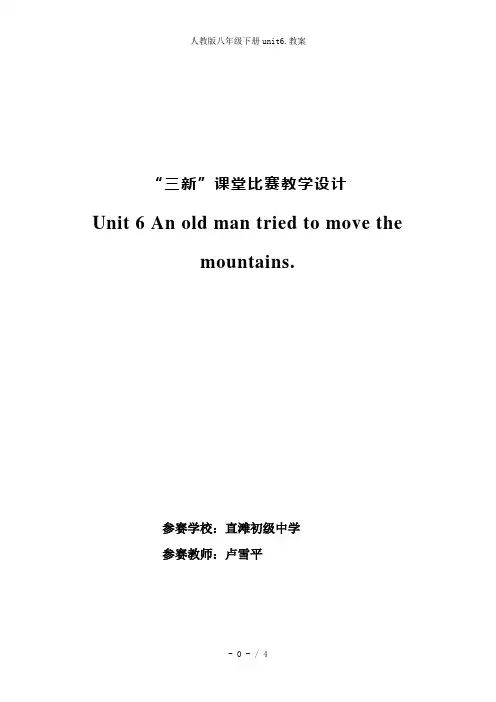
“三新”课堂比赛教学设计Unit 6 An old man tried to move themountains.参赛学校:直滩初级中学参赛教师:卢雪平Unit 6 An old man tried to moved the mountains.Section A 1 (1a-1c)Designer : Lu XuepijngTeaching Aims:1. Knowledge Objects:1) Master these words:shoot, once upon a time, stone,dig,hold.2) Ss can use the structures:① How does the story begin?② What happened next?2. Ability Objects:Ss can use English to ask the beginning, the presentation and results of stores. 3. Moral Objects:Ss will learn to face the problems in their schoolwork and their own life just like Yu Gong. And they should find out the correct way to deal with them.Teaching focus & difficulties1. Teaching focus:1) The new words:shoot, once upon a time, stone,dig,hold.2) the structures:How does the story begin?What happened next?2. Teaching difficultiesSs can use English to ask the beginning, the presentation and results of stores. And retell the simple stories.Teaching AidsA tape recorder, multimediaTeaching Procedure:Step 1 Lead in1. Play the video of Yu Gong moves the mountains to lead in.T: What’s the name of the story?S1:It’s Yu Gong moves a mountain.S2: It’s a traditional Chinese story.T: Do you know other traditional Chinese stories?S1: Ne Zha Conquers the Dragon KingS2: Magic Brush Ma LianS3: Chang’e Flies to the Moon…Step 2 Presentation1. Look at the pictures and guess the English names.(the main character)2.Match the pictures with the English names.3.Read the names of the story in the box.Step 3 Listening1.Before listening1) Learn the new words in the listening: once upon a time, stone,so…that, hold,dig,earth.2) Guess the main idea from the title and the three sentences.3) Circle the key words in each sentence.2.While listening1) Play the tape for the first time to get the main idea.2) Play again and check the answers.3. After listening1) Role- play the conversation in the listening.2) Read it by themselves3) Encourage Ss to retell the story.Step 4 Pair work1. Read the questions in the box in 1c.2. Ss discuss the questions with their partners.3. Let some pairs ask and answer the questions.e.g. A: How does the story happen?B: There were two very tall mountains in front of their house.A: What happened next?B: A very old man tried to move the mountains.A: Where would they put all the earth and stone from the mountains?B: They would put them into the sea.Homework:1. Recite the conversation in 2d after school.2. Tell the story Yu Gong Moves a Mountain in English to your parents. Once upon a time, there was a very old man…Blackboard Design :。
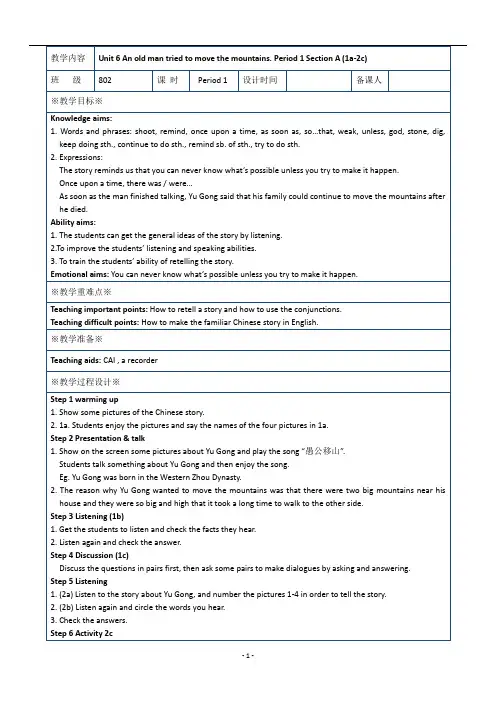
- 1 -- 3 -- 5 -Knowledge aims:1. Words: wife, husband, ground, voice, brave, bright, stepmother, scene2. Phrases: get lost, wake up, make a plan, in the moonlight, shining bright, change the plan, something bad,not… until, be make of, brave enough, plan to do sth.Ability aims: Be able to write a reasonable story ending according to the development of the story.Emotional aims: Reading makes a full man.※教学重难点※Teaching important points: To understand the performance of the western fairy tales, try to use the form of performance or generalization to carry out the language output.Teaching difficult points: The interpretation of the play and the proper use of words.※教学准备※Teaching aids: CAI※教学过程设计※Step 1 Talking1. (2a) Show some fairy tales. Tell Ss a fairy tale is an old, tradi tional story. Do you know what these fairy stories are about? Now discuss them with your partner.2. Ask some Ss say what they know about the fairy stories.e.g. Sleeping Beauty:A lovely princess had to sleep for 100 hundred years because of an evil magic. One hundred years later, ayoung prince came and saved the princes. They got married and had a happy life.Step 2 Reading1. Work on 2b. Tell Ss the following is a fairy tale. It’s name’s Hansel and Gretel.2. Before ReadingAsk Ss to read through the passage and decide what kind of text it is. Is it a letter, a play a short story or so mething else? (Ss may find out that it’s a play.)3. Fast Reading:1) T: Now let’s work on 2b. First, let’s read the questions and make sure we know the meanings of all thequestions. Then read the passage quickly and find the answers to the questions.2) Ss read the letter quickly and try to find the answers to the two questions.3) Check the answers with the class.4. Careful Reading: Work on 2c1) T: Now let’s read the play carefully and try to match each description below with the correct scene.2) Ss read the play care fully and try to match each description.3) Check the answers with the class.5. Post reading: Work on 2d1) Now let’s work on 2d. First read the questions below. Then try to read the play again and find the answersto the questions.2) Ss read the play again and try to find the answers to the questions.3) Let some Ss read their answers and correct their mistakes.4) Ss check their answers with their partners.Step 3 Language points1. One year, the weather was so dry that no food would grow.eg.: That bird’s song is so beautiful that we would follow it.2. We thought you were never coming back.We thought… 表示人们过去的某种想法,判断等,可以译作“我们原想……; 我们本以为……”。
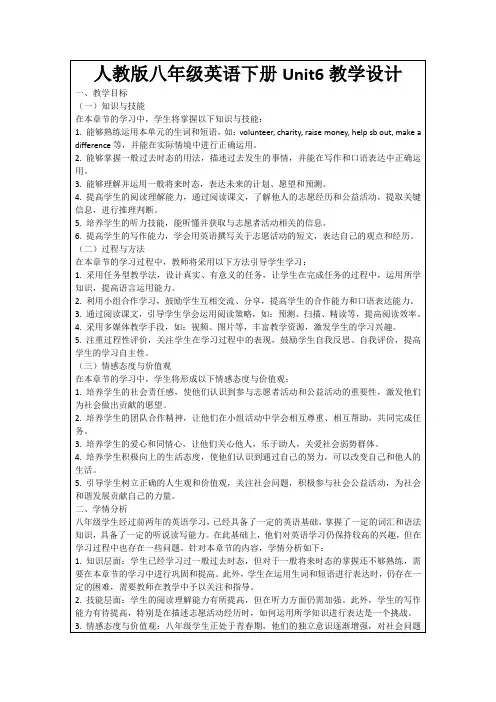
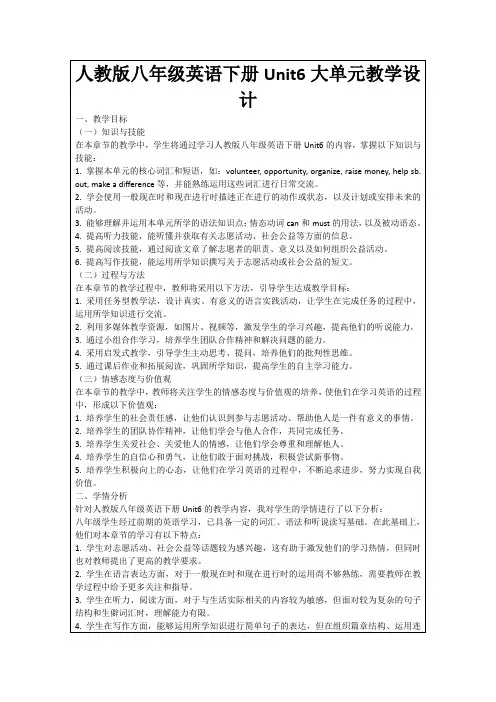
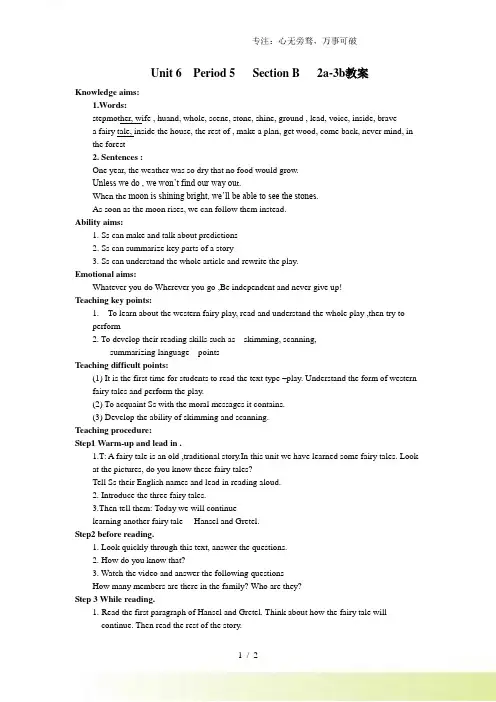
Unit 6 Period 5 Section B 2a-3b教案Knowledge aims:1.Words:stepmother, wife , huand, whole, scene, stone, shine, ground , lead, voice, inside, bravea fairy tale, inside the house, the rest of , make a plan, get wood, come back, never mind, inthe forest2. Sentences :One year, the weather was so dry that no food would grow.Unless we do , we won’t find our way ou t.When the moon is shining bright, we’ll be able to see the stones.As soon as the moon rises, we can follow them instead.Ability aims:1. Ss can make and talk about predictions2. Ss can summarize key parts of a story3. Ss can understand the whole article and rewrite the play.Emotional aims:Whatever you do Wherever you go ,Be independent and never give up!Teaching key points:1. To learn about the western fairy play, read and understand the whole play ,then try toperform2. To develop their reading skills such as skimming, scanning,summarizing language pointsTeaching difficult points:(1) It is the first time for students to read the text type –play. Understand the form of westernfairy tales and perform the play.(2) To acquaint Ss with the moral messages it contains.(3) Develop the ability of skimming and scanning.Teaching procedure:Step1 Warm-up and lead in .1.T: A fairy tale is an old ,traditional story.In this unit we have learned some fairy tales. Lookat the pictures, do you know these fairy tales?Tell Ss their English names and lead in reading aloud.2. Introduce the three fairy tales.3.Then tell them: Today we will continuelearning another fairy tale ---Hansel and Gretel.Step2 before reading.1. Look quickly through this text, answer the questions.2. How do you know that?3. Watch the video and answer the following questionsHow many members are there in the family? Who are they?Step 3 While reading.1.Read the first paragraph of Hansel and Gretel. Think about how the fairy tale willcontinue. Then read the rest of the story.2. Work on 2c.T: Now let’s read the play carefully and try to match each description below with the correct scene.Ss read the play quickly and try to match each description.3. Work on 2d Careful reading.Read the passage carefully and answer the following questions:Why does the wife tell her huand to leave the children in the forest?What does Hansel go out to get?Why does he do this in the moonlight?How do Hansel and Gretel find their way home?Why do Hansel and Gretel get lost the second time?4.At the same time write the key words from each scene and give the summary. Step 5 After reading.1.Guess what will happen and give the play an ending.Do you think they are in danger, why?What would happen when the old woman came out of the house?What will the brave children do?2. What do you think of Hansel and Gretel ?What can we learn form the fairy tale ?Step 6 Summarize and homework.。
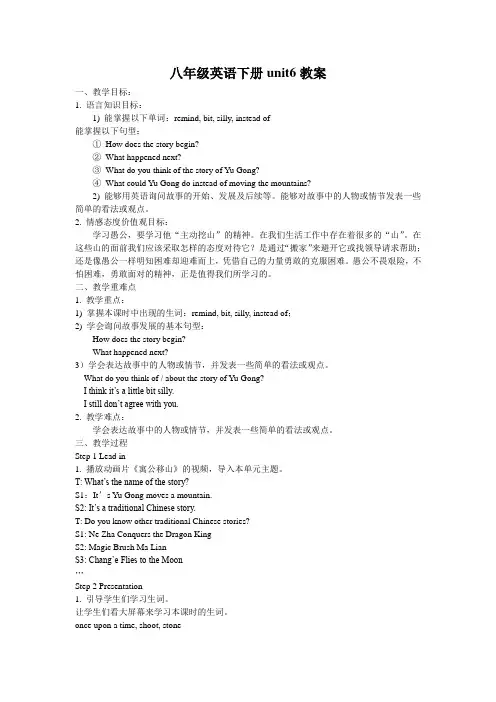
八年级英语下册unit6教案一、教学目标:1. 语言知识目标:1) 能掌握以下单词:remind, bit, silly, instead of能掌握以下句型:①How does the story begin?②What happened next?③What do you think of the story of Yu Gong?④What could Yu Gong do instead of moving the mountains?2) 能够用英语询问故事的开始、发展及后续等。
能够对故事中的人物或情节发表一些简单的看法或观点。
2. 情感态度价值观目标:学习愚公,要学习他“主动挖山”的精神。
在我们生活工作中存在着很多的“山”。
在这些山的面前我们应该采取怎样的态度对待它?是通过“搬家”来避开它或找领导请求帮助;还是像愚公一样明知困难却迎难而上,凭借自己的力量勇敢的克服困难。
愚公不畏艰险,不怕困难,勇敢面对的精神,正是值得我们所学习的。
二、教学重难点1. 教学重点:1) 掌握本课时中出现的生词:remind, bit, silly, instead of;2) 学会询问故事发展的基本句型:How does the story begin?What happened next?3)学会表达故事中的人物或情节,并发表一些简单的看法或观点。
What do you think of / about the story of Yu Gong?I think it’s a little bit silly.I still don’t agree with you.2. 教学难点:学会表达故事中的人物或情节,并发表一些简单的看法或观点。
三、教学过程Step 1 Lead in1. 播放动画片《寓公移山》的视频,导入本单元主题。
T: What’s the name of the story?S1:It’s Yu Gong moves a mountain.S2: It’s a traditional Chinese story.T: Do you know other traditional Chinese stories?S1: Ne Zha Conquers the Dragon KingS2: Magic Brush Ma LianS3: Chang’e Flies to the Moon…Step 2 Presentation1. 引导学生们学习生词。
八年级下册英语人教版第六单元教案全文共3篇示例,供读者参考篇1Unit 6: The Story of My VillageTeaching Objectives:1. Enable students to learn new vocabulary related to village life.2. Help students understand the simple past tense and practice using it in sentences.3. Develop students' listening, speaking, reading, and writing skills through various activities.Teaching Procedures:1. Warm-up (10 minutes):- Show students pictures of different villages around the world and ask them to describe what they see.- Discuss with students what they know about village life and compare it to their own experiences.2. Vocabulary Building (15 minutes):- Introduce new vocabulary related to village life, such as "farmers," "crops," "harvest," "livestock," etc.- Have students match the words with their meanings and practice using them in sentences.3. Listening Activity (20 minutes):- Play a recording of a person talking about their village and ask students to listen for specific details.- Have students answer questions about the information they heard and discuss it in pairs.4. Reading Comprehension (20 minutes):- Provide students with a passage about a village and have them read it silently.- Ask students questions about the main idea, details, and inferences in the text.5. Grammar Practice (15 minutes):- Introduce the simple past tense and explain the rules for forming regular and irregular verbs.- Have students practice using the simple past tense in sentences about village life.6. Speaking Exercise (15 minutes):- Divide students into pairs and have them take turns talking about their own village or a village they have visited.- Encourage students to use the new vocabulary and simple past tense in their descriptions.7. Writing Assignment (20 minutes):- Ask students to write a short paragraph describing a village they would like to visit.- Remind students to use the vocabulary and grammar they have learned during the lesson.8. Recap and Review (10 minutes):- Review the new vocabulary and grammar points with the class.- Allow students to ask any questions or share their thoughts on village life.Homework:- Assign students to write a diary entry about a day in the life of someone living in a village.- Encourage students to use the simple past tense and include the new vocabulary they have learned.Assessment:- Evaluate students based on their participation in class activities, understanding of the new vocabulary and grammar, and the quality of their written assignments.篇2Unit 6: TravelLesson 1: Travel DestinationsObjectives:- Students will learn vocabulary related to travel destinations.- Students will practice using the present perfect tense to talk about travel experiences.- Students will improve their speaking and listening skills through group discussions and role plays.Warm-up:Start the lesson by asking students about their dream travel destination. Encourage them to describe why they would like to visit that place and what they hope to do there.Vocabulary:Introduce new vocabulary related to travel destinations such as beach, mountains, city, countryside, historical sites, and landmarks. Use pictures and realia to help students understand the meanings of these words.Grammar focus:Explain and review the present perfect tense with students, emphasizing its usage to talk about travel experiences. Provide examples and ask students to practice forming sentences using the present perfect tense.Speaking activity:Divide the class into pairs or small groups and have them discuss the following questions:- Have you ever traveled to a foreign country?- What was your favorite travel destination and why?- What is on your travel bucket list?Role play:In groups of three or four, have students role play a conversation between travelers discussing their past travel experiences. Encourage them to use the present perfect tense in their dialogue.Homework:Ask students to write a short paragraph about their dream travel destination, using the present perfect tense to talk about any travel experiences they have had.Lesson 2: Planning a TripObjectives:- Students will learn vocabulary related to planning a trip.- Students will practice using modal verbs to make suggestions and give advice.- Students will improve their reading and writing skills through a travel planning activity.Warm-up:Review the vocabulary from the previous lesson by asking students to brainstorm a list of items they would need for a trip.Encourage them to categorize the items into must-have, should-have, and nice-to-have.Vocabulary:Introduce new vocabulary related to planning a trip such as itinerary, accommodations, transportation, attractions, and activities. Provide examples and ask students to practice using the words in sentences.Grammar focus:Explain and review modal verbs such as should, could, and must for making suggestions and giving advice. Provide examples and ask students to practice using the modal verbs in context.Reading activity:Distribute a travel itinerary to each student and have them read the details carefully. Ask comprehension questions to check their understanding of the itinerary.Writing activity:In pairs or small groups, have students create their own travel itinerary for a trip to a fictional destination. Encouragethem to include details such as accommodations, transportation, attractions, and activities.Homework:Ask students to write a short essay about their dream trip, using modal verbs to make suggestions and give advice on what to do and see.Lesson 3: Travel StoriesObjectives:- Students will learn vocabulary related to travel experiences.- Students will practice using the past simple tense to narrate travel stories.- Students will improve their listening and speaking skills through storytelling activities.Warm-up:Start the lesson by asking students to share a memorable travel experience they have had in the past. Encourage them to describe the place they visited, what they did there, and how they felt.Vocabulary:Introduce new vocabulary related to travel experiences such as adventure, cultural exchange, cuisine, hospitality, and souvenirs. Use pictures and realia to help students understand the meanings of these words.Grammar focus:Explain and review the past simple tense with students, emphasizing its usage to narrate travel stories. Provide examples and ask students to practice forming sentences using the past simple tense.Listening activity:Play a recording of a travel story and have students listen carefully. Ask comprehension questions to check their understanding of the story.Speaking activity:In pairs or small groups, have students take turns narrating their own travel stories using the past simple tense. Encourage them to include details such as the setting, characters, events, and emotions.Homework:Ask students to write a short paragraph summarizing a travel story they have heard or read, using the past simple tense to narrate the events.Overall, this unit is designed to help students improve their English skills while learning about travel destinations, planning trips, and sharing travel stories. By the end of the unit, students should feel more confident in using vocabulary related to travel and expressing themselves fluently in English.篇3Unit 6: I'm watching TVPart one: Teaching goals1. Enable students to master the new words and phrases.2. Help students understand and use the present continuous tense.3. Encourage students to describe ongoing actions using the present continuous tense.Part two: Teaching key points1. Vocabulary: New words and phrases related to daily activities and actions.2. Grammar: Present continuous tense and its usage.3. Speaking: Encouraging students to use the present continuous tense to describe ongoing actions.Part three: Teaching difficult points1. Differentiating between the present simple tense and the present continuous tense.2. Encouraging students to form questions and negative sentences using the present continuous tense.3. Guiding students to express ongoing actions in a clear and concise manner using the present continuous tense.Part four: Teaching methods1. Task-based learning: Engaging students in various activities to practice using the present continuous tense.2. Group work: Encouraging students to work together to complete tasks and exercises related to the lesson.3. Role-playing: Providing scenarios for students to act out using the present continuous tense.4. Visual aids: Using pictures, videos, and realia to help students understand and remember new vocabulary and sentence structures.Part five: Teaching procedures1. Warm-up activity: Introducing the topic of daily activities and actions.2. Vocabulary introduction: Presenting new words and phrases related to daily activities.3. Grammar explanation: Introducing the present continuous tense and its formation.4. Practice activities: Engaging students in exercises to practice forming sentences using the present continuous tense.5. Group work: Dividing students into groups to complete tasks using the present continuous tense.6. Role-playing: Providing scenarios for students to act out using the present continuous tense.7. Review: Going over the key points of the lesson and providing additional practice exercises.8. Homework: Assigning tasks for students to practice using the present continuous tense in writing.Part six: Assessment1. Observing students' participation in class activities.2. Assessing students' understanding of the present continuous tense through exercises and tasks.3. Reviewing students' homework assignments to evaluate their use of the present continuous tense in writing.Part seven: ConclusionBy the end of this unit, students should be able to accurately use the present continuous tense to describe ongoing actions and activities. They should also be able to differentiate between the present simple tense and the present continuous tense. Through various activities and exercises, students will have the opportunity to practice using the present continuous tense in both spoken and written forms.。
八下英语人教unit 6教案教案标题:Unit 6: I'm going to study computer science.教学目标:1. 语言目标:学生能够掌握并正确运用本单元的词汇和短语,如computer science, astronaut, engineer, etc. 学生能够运用一般将来时表达自己的未来计划。
2. 情感目标:培养学生对未来职业的兴趣和探索,激发学生的职业理想和目标。
教学重点:1. 学习并正确运用本单元的词汇和短语。
2. 学习并正确运用一般将来时表达自己的未来计划。
教学难点:1. 运用一般将来时表达自己的未来计划。
2. 运用本单元的词汇和短语进行口语和写作表达。
教学准备:1. 教材:《人教版英语》八年级下册2. 多媒体设备3. 学生练习册教学过程:Step 1: Warm-up (5 minutes)1. Greet the students and review the previous lesson's vocabulary related to future plans.2. Show pictures of different occupations and ask students what they want to bein the future. Encourage them to explain why they are interested in thoseoccupations.Step 2: Presentation (15 minutes)1. Introduce new vocabulary words related to future occupations, such as computer science, astronaut, engineer, etc. Use pictures, gestures, and real-life examples to help students understand the meanings.2. Present the structure of the future tense using "be going to." Explain the usage and form of this tense.3. Provide examples of sentences using the future tense and ask students to identify the structure and meaning.Step 3: Practice (20 minutes)1. Divide the class into pairs or small groups and give each group a list of future occupations.2. Students take turns asking and answering questions about their future plans using the future tense. Encourage them to use the new vocabulary words.3. Monitor the groups and provide assistance when needed.Step 4: Production (15 minutes)1. Ask students to write a short paragraph about their future plans using the future tense and the vocabulary words from the unit.2. Encourage students to be creative and explain why they are interested in their chosen occupation.3. Allow some students to share their paragraphs with the class if time permits. Step 5: Review and Closure (5 minutes)1. Review the key vocabulary words and the structure of the future tense withthe whole class.2. Summarize the main points of the lesson and ask students if they have any questions or need further clarification.教学延伸:可以邀请一些职业人士来学校,与学生分享他们的职业经历和对未来的展望,以激发学生对不同职业的兴趣和理解。
八年级英语下册unit6教案一、教学目标:1. 语言知识目标:1) 能掌握以下单词:remind, bit, silly, instead of能掌握以下句型:①How does the story begin?②What happened next?③What do you think of the story of Yu Gong?④What could Yu Gong do instead of moving the mountains?2) 能够用英语询问故事的开始、发展及后续等。
能够对故事中的人物或情节发表一些简单的看法或观点。
2. 情感态度价值观目标:学习愚公,要学习他“主动挖山”的精神。
在我们生活工作中存在着很多的“山”。
在这些山的面前我们应该采取怎样的态度对待它?是通过“搬家”来避开它或找领导请求帮助;还是像愚公一样明知困难却迎难而上,凭借自己的力量勇敢的克服困难。
愚公不畏艰险,不怕困难,勇敢面对的精神,正是值得我们所学习的。
二、教学重难点1. 教学重点:1) 掌握本课时中出现的生词:remind, bit, silly, instead of;2) 学会询问故事发展的基本句型:How does the story begin?What happened next?3)学会表达故事中的人物或情节,并发表一些简单的看法或观点。
What do you think of / about the story of Yu Gong?I think it’s a little bit silly.I still don’t agree with you.2. 教学难点:学会表达故事中的人物或情节,并发表一些简单的看法或观点。
三、教学过程Step 1 Lead in1. 播放动画片《寓公移山》的视频,导入本单元主题。
T: What’s the name of the story?S1:It’s Yu Gong moves a mountain.S2: It’s a traditional Chinese story.T: Do you know other traditional Chinese stories?S1: Ne Zha Conquers the Dragon KingS2: Magic Brush Ma LianS3: Chang’e Flies to the Moon…Step 2 Presentation1. 引导学生们学习生词。
人教版八年级英语下册第六单元教案Unit 6 An old man tried to move the mountains.教材解读本单元的核心话题是用中国民间故事和西方童话故事。
通过对故事的了解和学习,使学生能够学会讲述故事,在讲述过程中恰当使用连词,符合英语的语言逻辑习惯和表达;同时能更进一步地尝试演绎剧本。
在此过程中学生对本单元语言目标加以巩固,综合能力得以提升。
单元目标一、知识与技能1. 词汇:shoot,remind,hide,excite,fit,smile,marry,cheat.shine.lead,god,bit,stick,tail,couple,object,etc2. 常用表达:once upon a time ,instead of,turn…into…,get married,as soon as3. 语法:学会在叙述故事中运用as soon as,unless,so…that 等连词,能借助how,1what,who,why 等引导的疑问句完成故事的叙述。
How does the story begin?What happened next?Why was Yu Gong trying to move the mountains?Who is the Monkey King?4. 能力目标:流利地、正确地用英语讲述故事。
二、过程与方法灵活运用教材,从所教学生的实际水平和语言能力出发,调整和取舍教学内容,合理安排本单元的课时数,设计好每课时的教学内容。
三、情感态度与价值观1.通过课堂的合作互动,增进同学间的了解,增进感情。
2.通过了解古代寓言故事和西方故事,学习故事中所蕴含的哲理。
23.了解自己的能力,培养情操。
4.培养学生们对英语的兴趣。
教法导航1. 以任务型教学作为课堂教学理念、利用整体语言教学法、情景教学法、交际教学法等。
2. 在教学中创设切实可行的任务型教学活动、突出交际性。
人教版八年级下册英语Unit 6集体备课教案一、教学目标知识目标:学生掌握与旅行相关的词汇和表达方式,能够阅读并理解关于旅行的简单文章。
能力目标:学生能够运用所学知识进行简单的旅行计划制定和描述,提高口语表达和写作能力。
情感目标:培养学生对旅行的热爱,通过旅行体验不同的文化和风景,增强跨文化交流的意识。
二、教学内容重点词汇:掌握与旅行相关的重点词汇,如景点、交通工具、住宿等。
句型表达:学习旅行计划的制定和描述的常用句型。
阅读理解:通过阅读简单的文章,理解旅行的意义和价值。
口语练习:模拟旅行情境,进行口语表达练习。
写作训练:根据所学知识,写一篇旅行计划或旅行日记。
三、教学难点与重点难点:如何引导学生运用所学知识进行口语表达和写作训练。
重点:掌握与旅行相关的词汇和表达方式,理解旅行的意义和价值。
四、教具和多媒体资源黑板:用于书写重点词汇和句型。
投影仪:播放与旅行相关的图片和视频,增强学生对旅行的感性认识。
教学软件:用于进行互动练习和测试。
五、教学方法激活学生的前知:通过提问学生过去的旅行经历和感受,激活学生的相关背景知识。
教学策略:采用讲解、示范、小组讨论、角色扮演等多种教学方法,引导学生积极参与课堂活动。
学生活动:组织学生进行旅行计划制定、口语表达和写作训练等活动,提高学生的实践能力和合作意识。
六、教学过程导入(5分钟)通过投影仪展示一些美丽的旅行景点图片,吸引学生的注意力。
随后提问学生关于旅行的感受和经历,引导学生进入本单元的主题。
讲授新课(30分钟)(1)介绍本单元的重点词汇和句型,通过例句和情境模拟帮助学生理解并运用。
(2)阅读理解:让学生阅读一篇关于旅行的文章,并提出问题让学生回答,检验学生的理解程度。
(3)口语练习:组织学生进行小组讨论,制定一个简单的旅行计划,并进行口头表达。
教师给予指导和反馈。
(4)写作训练:让学生写一篇旅行计划或旅行日记,要求运用所学知识,注意语法和拼写错误。
教师给予指导和评价。
“三新”课堂比赛教学设计
Unit 6 An old man tried to move the
mountains.
参赛学校:直滩初级中学
参赛教师:卢雪平
Unit 6 An old man tried to moved the mountains.
Section A 1 (1a-1c)
Designer : Lu Xuepijng
Teaching Aims:
1. Knowledge Objects:
1) Master these words:shoot, once upon a time, stone,dig,hold.
2) Ss can use the structures:
① How does the story begin?
② What happened next?
2. Ability Objects:
Ss can use English to ask the beginning, the presentation and results of stores. 3. Moral Objects:
Ss will learn to face the problems in their schoolwork and their own life just like Yu Gong. And they should find out the correct way to deal with them.
Teaching focus & difficulties
1. Teaching focus:
1) The new words:shoot, once upon a time, stone,dig,hold.
2) the structures:
How does the story begin?
What happened next?
2. Teaching difficulties
Ss can use English to ask the beginning, the presentation and results of stores. And retell the simple stories.
Teaching Aids
A tape recorder, multimedia
Teaching Procedure:
Step 1 Lead in
1. Play the video of Yu Gong moves the mountains to lead in.
T: What’s the name of the story?
S1:It’s Yu Gong moves a mountain.
S2: It’s a traditional Chinese story.
T: Do you know other traditional Chinese stories?
S1: Ne Zha Conquers the Dragon King
S2: Magic Brush Ma Lian
S3: Chang’e Flies to the Moon
…
Step 2 Presentation
1. Look at the pictures and guess the English names.
(the main character)
2.Match the pictures with the English names.
3.Read the names of the story in the box.
Step 3 Listening
1.Before listening
1) Learn the new words in the listening: once upon a time, stone,
so…that, hold,dig,earth.
2) Guess the main idea from the title and the three sentences.
3) Circle the key words in each sentence.
2.While listening
1) Play the tape for the first time to get the main idea.
2) Play again and check the answers.
3. After listening
1) Role- play the conversation in the listening.
2) Read it by themselves
3) Encourage Ss to retell the story.
Step 4 Pair work
1. Read the questions in the box in 1c.
2. Ss discuss the questions with their partners.
3. Let some pairs ask and answer the questions.
e.g. A: How does the story happen?
B: There were two very tall mountains in front of their house.
A: What happened next?
B: A very old man tried to move the mountains.
A: Where would they put all the earth and stone from the mountains?
B: They would put them into the sea.
Homework:
1. Recite the conversation in 2d after school.
2. Tell the story Yu Gong Moves a Mountain in English to your parents. Once upon a time, there was a very old man…
Blackboard Design :。